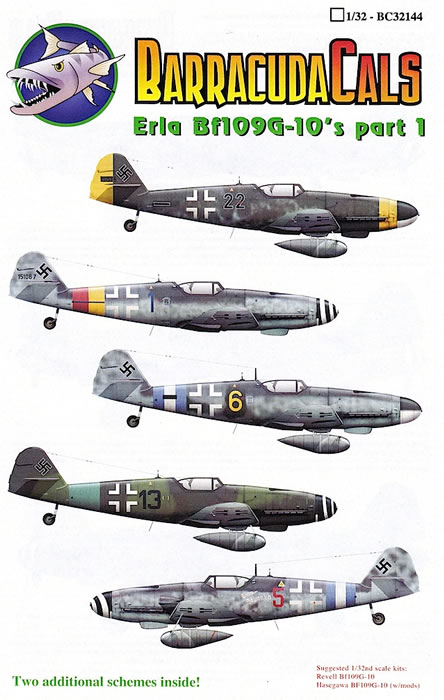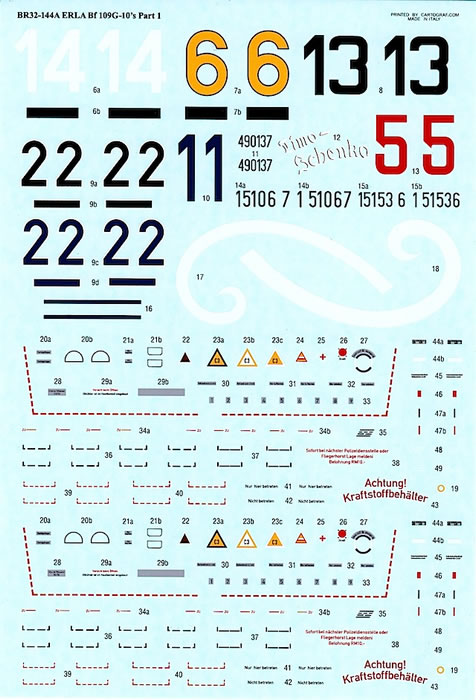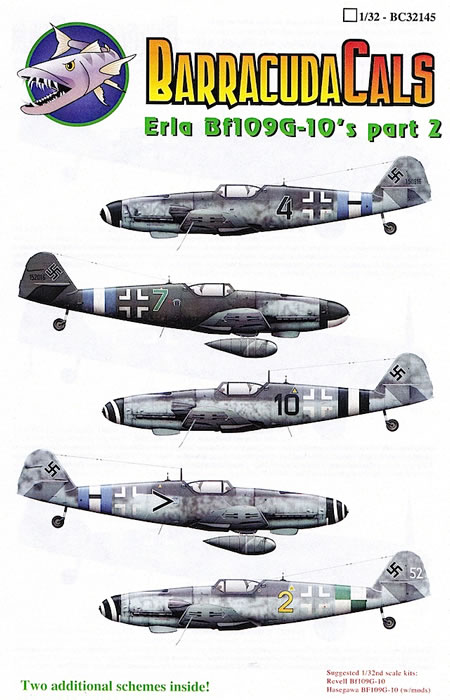Erla Bf 109 G-10s
Parts 1 and 2

BarracudaCals,
1/32 scale
S u m m a r y : |
Catalogue Number, Description and Scale: |
BarracudaCals Item Nos.
BC32144 - Erla Bf 109 G-10s Part 1
BC32145 - Erla Bf 109 G-10s Part 2 |
Scale: |
1/72 |
Contents & Media |
Each contains 1 x full colour fold out instruction leaflet; 1 x black-and-white stencil placement guide; 2 x decal sheets. |
Price: |
US$14.95 each plus shipping available online from Barracuda Studios |
Review Type: |
First Look |
Advantages: |
Interesting subjects; high quality decals; comprehensive instructions; great profile art. |
Disadvantages: |
None noted. |
Conclusion: |
These two excellent releases from Barracuda Studios should be considered by anyone building Revell's 1/32 Erla G-10 – highly recommended. |
Reviewed by Brad Fallen

Xtradecal's 1/72 scale DH.82a Tiger Moth Pt.1 is available online from Squadron.com
Revell released its 1/32 scale Erla-built Bf 109 G-10 kit just over 12 months ago. The kit has generally been well received, with Brett Green and other reviewers noting a number of improvements over the original Bf 109 G-6 kit on which it is based.
Revell's marking options are for a likely RLM 75 Grey Violet and RLM 83 Dark Green over RLM 76 Light Blue G-10 flown by Erich Hartmann in April 1945, and a JG 300 machine finished in one of several possible late war colour combinations. Both are reasonable selections, but the chaos of Luftwaffe administration in late 1944 and early 1945 saw G-10s camouflaged in a variety of interesting schemes. 13 such aircraft are covered in these two releases from Barracuda Studios, along with the only known Erla-built Bf 109 K-4.
Featured Bf 109s are as follows.
Part 1

- 'White 14', ex-II,/JG 3 machine based at Garz, Germany and flown by Waldemar Wagler of JG 51 to Rinakby, Sweden, on 24 April 1945. Camouflage RLM 74 Grey Green and RLM 75 Grey Violet over RLM 76 Light Blue, with replacement rudder in RLM 75 and RLM 81 Brown Violet.
- 'Yellow 6', assigned to JGr.300 and found by Allied troops at Neubiberg, Germany at the end of the war. 74/75/76 camouflage with previous fuselage number overpainted in a darker colour; blue-white-blue fuselage band.
- 'Black 13', possibly operated by JG 27 and photographed by US troops at an unknown location in Germany in June 1945. Fuselage and upper wings probably 81 and RLM 82 Bright Green over natural metal lower wing surfaces; green fuselage band.
- 'Red 5' flown by Friedrich-Wilhelm 'Timo' Schenk of 2./JG 300, Borkheide, Germany, February 1945. Camouflage is 74/75/76 with blue/white/blue fuselage band.
- 'Blue 1' of JG 301, found abandoned and photographed by US troops at Erfurt Nord, Germany, spring 1945. 74/75/76 but with unpainted lower wings and red/yellow fuselage band.
- 'Black 22' of 5./JG 52, pilot and location unknown. 74/75/76 fuselage with 81 overspray, and likely replacement tail unit and engine cowling in 81/82. Wing upper surfaces in overall 81, with lower surfaces unpainted metal. Forward engine cowling and rudder RLM 04 Yellow.
- The final Bf 109 on this sheet had no identity markings and was likely finished in similar camouflage to 'Black 13'.
Part 2

- 'Black 4' of JGr.300, found abandoned at Langensalza, Germany in June 1945. 74/75/76 with unpainted lower wing surfaces and blue-white-blue fuselage band.
- 'Yellow 2' of KG(J) 27, found at Kaufbeuren, Germany, in May 1945 (minus wings and wheels). 74/75/76 or possibly RLM 77 Light Grey and RLM 75 over 76. Green and white-checkered fuselage band.
- 'Black 10' of I./JG 4, found abandoned and photographed by US troops at Giessen, Germany in June 1945. 74/75/76 with unpainted lower wings and black and white fuselage band.
- 'Black Chevron' of JGr.00, pilot and location unknown. 74/75/76 with blue-white-blue fuselage band.
- 'Green 7' of 11./JG 300 at Prague-Kbely in May 1945. Upper surfaces likely overall 81, with 74/75/76 engine cowling and unpainted lower wing surfaces. Band around front of cowling is likely RLM 70 Black Green and fuselage band is blue-white-blue.
- 'Yellow 24' flown by Antonius Woffen of 6./JG 27, crash landed behind Allied lines on 11 March 1945. 74/75/76 with previous fuselage identification number overpainted in a darker colour. Green fuselage band.
- Bf 109 K-4, W.Nr 570375 but no other identification markings and unit, pilot and location unknown. The only known Erla-built K-4, this aircraft was likely finished in overall RLM 81 with unpainted lower wings.

The accompanying instructions (which can also be downloaded from the Barracuda Studios website) are typically comprehensive. For each set these consist of a fold out leaflet with full-colour port or starboard profiles of each aircraft, along with two generic upper and lower surface views (one for 74/75 camouflage and the other for late-war 81/82). The profiles are by Anders Hjortsberg who does a great job of conveying the subtlety and complexity of many of the schemes on offer.
Each profile is accompanied by a brief but detailed description of the Bf 109 and its background (to the extent that the latter is known, given that a number of the machines were photographed as post-war wrecks). Amongst the useful information included is whether the wing leading edge camouflage demarcation is wavy or straight, and the type of wheel fitted – details that can have a subtle effect on the look of your finished model.
Numbers and arrows are used to indicate decal placement, removing any doubt about correct placement. This is especially important in relation to airframe stencils; Barracudacals recognises this and provides detailed black-and-white port and starboard profiles that clearly signpost stencil locations (along with options where this is appropriate). The stencil guide also includes a template for masking the overpainted fuselage number on 'Yellow 24', and an illustration of wheel stencil placement locations.
The decals are printed by Cartograf and look superb, with crisp borders, good colour density and minimal carrier film. (I like how Cartograf has avoided using carrier film in the middle of numbers such as 0, 4, and 4, thus removing a potential source of silvering.)
Each set contains two decal sheets: one of stencils and individual aircraft markings, and the other of national markings and spinner spirals. The latter sheets appear to be identical in each set, notwithstanding the fact they're marked as 'Part 1' and 'Part 2'. The stencil data in each set is also (unsurprisingly) identical.
These are two more excellent releases from Barracuda Studios and should at least be considered by anyone building Revell's 1/32 Erla G-10 kit. To see how good these markings are on a finished model, look at Brett Green's model of 'Black 4' that he completed using decals from Part 1.
With sufficient stencils and national markings in each set to complete at least two aircraft, you'll also have plenty of spares for future 1/32 Bf 109 projects.
Highly recommended.
Thanks to BarracudaCals for this sample.
Text and Images Copyright © 2016 by Brad Fallen
This Page Created on 6 July, 2016
Last updated
6 July, 2016
Back to
HyperScale Main Page

|
